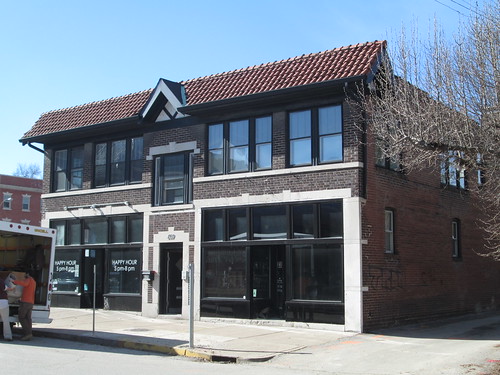
Demolition are beginning this week in the Loop to make way for Washington University's new Loop Living development. Those coming down include four buildings dating from the early 1920's near the intersection of Delmar & Eastgate. Of these, probably most significant of is 609 Eastgate, which until recently housed a series of sushi restaurants and two apartments above. With its simple but elegant stone trim and decorative red tile roof, this building epitomizes the typology of structures that make up commercial districts throughout the City and inner suburbs.
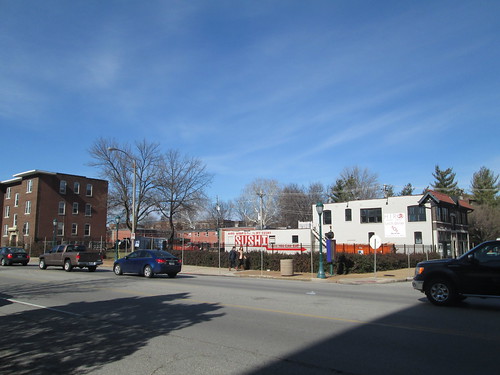
At the corner, just south of the 609 building, is a lot that with 150 of frontage on Delmar has been vacant for several years since an abandoned Meineke Muffler shop was cleared.
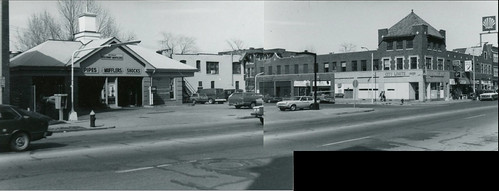
The Meineke building, originally a Standard gas station was built in 1965. This photo from a 1983 architectural survey of the Parkview Gardens neighborhood illustrates the gap created in the Delmar streetscape by this automotive user. Across Eastgate, the storefronts of the corner space that most recently housed the Delmar Lounge have been restored since this photo. Coming soon to this space will be the Mission Taco Joint. a new tacoria that will serve duck tacos among other specialties.
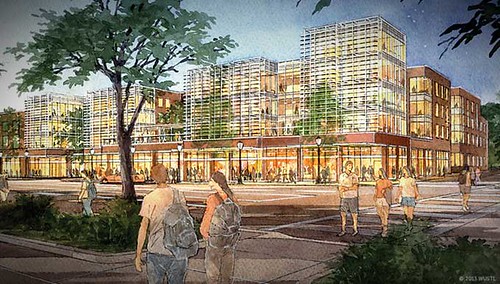
The Loop Living development will feature two 4-5 story buildings fronting on Delmar with continuous retail on the first floor and student apartments above. The first phase will include the two buildings on Delmar and two on Enright. A pedestrian walkway will connect Delmar and Enright between the buildings. Note that the courtyard shown in building 1A above will be at the 2nd floor with retail space continuous fronting Delmar below. The design of the buildings by William Rawn Associates, Architects of Boston with associate architect Tao + Lee Associates, Inc. of St. Louis, especially along Delmar, is a refreshing departure from the traditional styles used in newer student housing on WU's main campus and South 40.
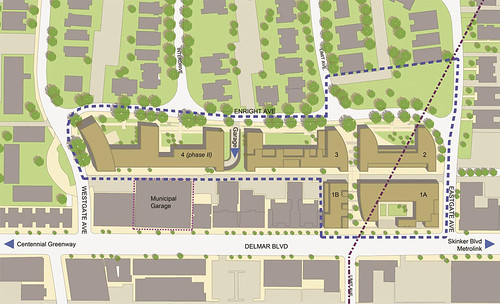
The 609 Eastgate building is located at the far northwest corner of the Skinker DeBaliviere-Catlin Tract-Parkview Historic District. Washington University presented the Loop Living proposal to the Historic District Committee, of which I am a member, last year. While we were of course not thrilled with the idea of losing the 609 building (the other buildings are out of our jurisdiction), we felt that the overall improvement that this development will bring to the Loop and to the vacant Meineke lot that is in the historic district outweigh the loss of the building. The new retail spaces on Delmar that will be part a major component of this development along with the recently added one-story retail building that houses Dick Blick will go a long way toward bringing together the west Loop and more recently developed east Loop.
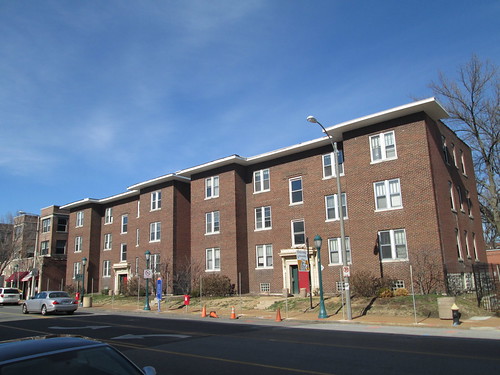
Immediatly west of the Meineke lot are two 6-family apartment buildings that will also come down. These buildings at 6255 and 6263 Delmar were built by John M. Cook for developer Victor E. Rhodes in 1921. Rhodes and son-in-law Cook built about 15 buildings in the Parkview Gardens neighborhood. The deep overhangs featured exposed rafters that are now hidden by metal or vinyl soffiting and were originally capped with a tile coping at the front edges.
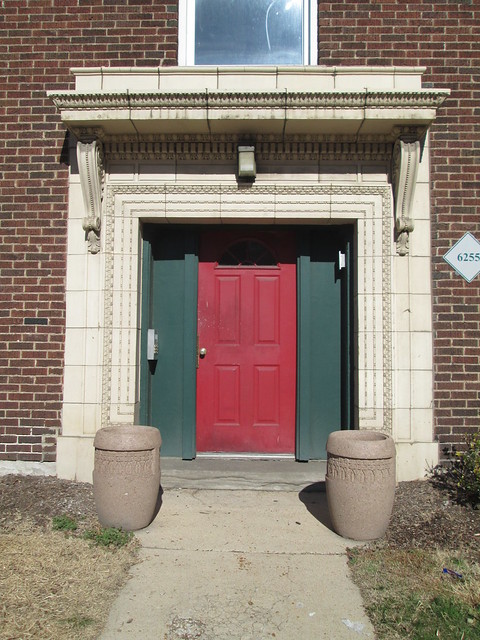
The highly decorative terra cotta entrances seem almost out of place on these buildings which are almost devoid of ornamentation. I would have expected to see an entrance with either a small tile roof in the arts & crafts style or an even simpler entrance with pain stone banding of no ornament at all as is typified my many of the buildings in the blocks north.

The buildings at 6255 & 6263 Delmar have twins two buildings to the west at 6301-05 and 6307-09 Delmar also built in 1921. The storefronts of the building above were added to the building in 1935 in a streamlined style that has been altered. The apartment entrance was moved to the west side.
The Jacobethan style storefronts at the building below with extended central apartment entrance were added in 1928 by architect Norman B. Howard. Unfortunately since the 1983 photo from the architectural survey, the broad overhangs on this building have been hacked back to within a foot of the building face and leaving the edge of the roofing drooping over the edges. Norman B. Howard also designed a storefront addition in the same Jacobethan style connecting two 1919 apartment buildings at 6265-77 Delmar.
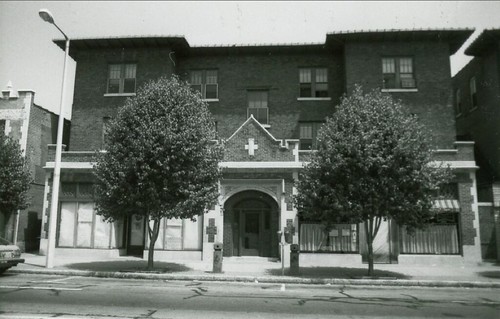
Unlike storefront additions to homes in other parts of St. Louis where the original setback was greater, these are not simply additions to the front of the buildings. Instead, they were complex transformations carving out the spaces of the ground floor apartments and adding structural capacity to span the width of the stores. The floor line of the former apartments were also lowered to sidewalk level at least in the front portions by filling in the portion of the basements extending below grade. In the late 1920's though retail trade in the Loop was booming enough to make such expensive transformations a lucrative investment. Please note that none of these buildings with retail spaces west of 6255 and 6263 Delmar are part of the new development.

The last of the four pre-war buildings is this arts & crafts style 6-family at 6236 Enright built by R. E. Jones in 1921. This building is located on the curve as Eastgate and Enright come together and while it is a nice building, it has always like the odd man out due to the loss of historic context west of the building. In the 1960's, the entire Parkview Gardens neighborhood was labeled an Urban Renewal Area, and even in the 1983 architectural survey, the historic buildings were listed as endangered due to this designation.
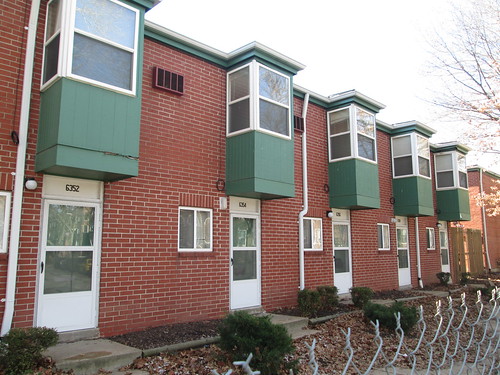
One of the only large scale clearance and redevelopment projects that occurred as a result of the urban renewal designation was the construction of the University Terrace Apartments on Enright. Fourteen original buildings from the 1920's were cleared on the south side of the 62 and 6300 blocks of Enright to make way for the modern apartments. One of the demolished buildings at 6254 Enright was the home of Tennessee Williams during the time he was a student at University City High School from 1926 to 1930.
The design of the apartments by Anselevicius & Montgomery was chosen in a competition sponsored by HUD. George Anselevicius was a professor at the Washington University School of Architecture, and would later become dean of the school. Most are rows of two story townhomes with the exception of a four story block at Enright and Westgate.
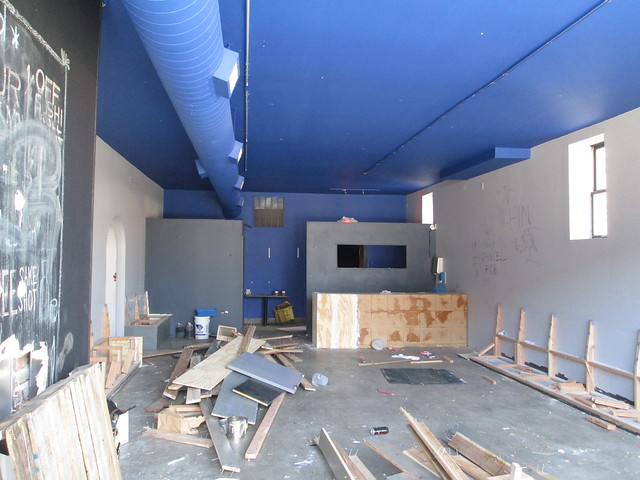
When I went to photograph the buildings that are coming down recently, I happened to run into Eric Schwartz, who recently founded Refab, which is a local nonprofit organization that promotes sustainability and re-use of our built environment by salvaging usable materials from buildings slated for demolition. Refab's first contract is the buildings slated for demolition for Loop Living.

Eric and his crew were hard at work removing everything that can conceivably be re-used from the buildings. I got a chance to take a look inside, and they have stripped these units bare, including all the hardwood flooring. So while we are losing these buildings, at least it is being done in a sustainable manner.
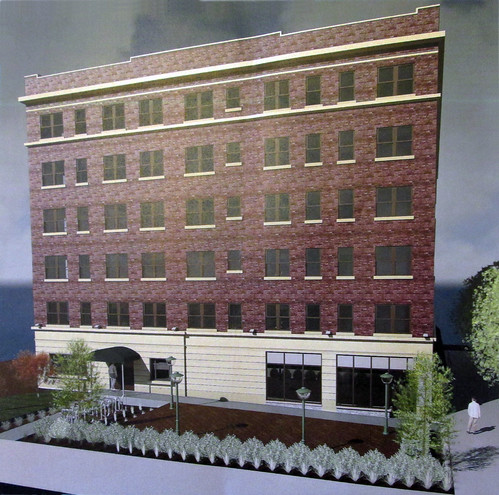
Speaking of sustainability, just around the corner on Skinker at McPherson, Wash U is going for a building permit this week for the complete rehabilitation of the Parkview Apartments. The historic six-story structure built in 1923 was designed by Edward F. Nolte, who was the architect of the building that houses Blueberry Hill, the Lambskin Masonic Temple on Kingshighway and several Craftsman style homes and apartments in the Skinker DeBaliviere neighborhood. Washington University initially planned to begin the renovation last year, but the construction budget was higher than anticipated.
So what did they do? They formed a for-profit entity and will be getting state and federal historic rehabilitation tax credits in order make the project financially more feasible. This is an example that a certain other local university should look into for a certain building at the corner of Grand and Chouteau!

8 comments:
Why couldn't this new urbanism have been scaled down to fit between the existing buildings?
While I too love the added density, retail continuity etc, this does seem to perpetuate the idea that all progress starts with demo of what is there.
in other cities (e.g. D.C.) you see old structures incorporated into new ones all over the place. there's no reason that 609 couldn't have been incorporated into this development. they could have simply built around or over it. and i don't see how building around it would have increased the expense of construction.
and i just don't get demolishing 6236–a well-built, well-maintained and highly attractive residential building–in order to replace it with... a residential building. it's just a complete waste.
even the more "enlightened" developers in STL don't seem to value our architectural heritage as much as those in more progressive cities value theirs.
The loss of 609 is regrettable. I noticed it was coming down yesterday on the way back from the airport. I had not been following this project closely and had hoped 609 might have been incorporated into the project in the end. Yes this would have been a costly and uneconomic choice but sometimes it's just worth it, if only intrinsically.
Save the decorative entrances, 6236 has had nearly all it's charm "upgraded" out of it over the last 30+ years. Historic preservation is important but improvements in building technology allow us to construct new buildings that are more comfortable, more efficient, built more cheaply (could argue this is a bad thing) and with far less compromises.
In the end this new project helps build up Delmar as a proper urban development. Storefronts to curb with apartments above is a good thing...had this projected tuned into a CVS, bank or petrol station with parking I would have incited a revolt.
If the 609 building had been located on Delmar, I believe our Historic District Committee would have pressed to have the building incorporated in the new development, or at least the front portion of the building.
This is what was done with the front of the funeral home at the front of the Moonrise Hotel, and the juxtaposition of the old facade and the tower is not perfect, it give a good human scale to the sidewalk that otherwise would not exist.
I noticed that the three-story University Terrace apartment building at the corner of Enright & Westgate ( is still occupied and not fenced off like the rest of the complex. I thought this building was also in the footprint of the new development. Is this going to be torn down in a later phase, or is this building being spared? I think it would be really cool if this building were retained as little remnant of the old-school urban renewal era. Here's the building I'm referring to: https://maps.google.com/maps?q=enright+%26+westgate,+university+city,+mo&hl=en&ll=38.656318,-90.303841&spn=0.00475,0.010568&sll=38.656818,-90.304485&layer=c&cbp=13,117.63,,0,0.8&cbll=38.656818,-90.304485&hnear=Enright+Ave+%26+Westgate+Ave,+University+City,+St+Louis,+Missouri+63130&t=m&z=17&panoid=lfTVxFwaPs-JpHSsYx7aFQ
The building at Enright & Westgate is within the phase 2 portion of the Loop Living development. I'm not sure what their schedule is to begin phase 2 (I would guess a year or so). I assume they will vacate that building soon shortly before demolition.
I grew up in Florissant but I experienced the loop all throughout highschool. It's a great place to walk around and enjoy. When it came time to selecting a place to live, with my girlfriend and I having jobs in Clayton & Brentwood, never once did we consider the loop. I understand people's issues with losing recognizable surroundings (much like florissant losing beautiful landmarks like Herman's Farm to another subdivision) but I do think the loop is trending up and needs to update it's looks to match it's image. The loop is the closest thing St. Louis has to a trendy environment. Tons of artists, youth and young adults stroll through the loop to see the latest band, enjoy the newest restaurants, and/or see the latest designs in furniture/clothes. Plus, it doesn't hurt to introduce newer (possibly wealthier) residents to that area, especially when that area as at a dangerous balancing act (think washington street downtown)
Post a Comment